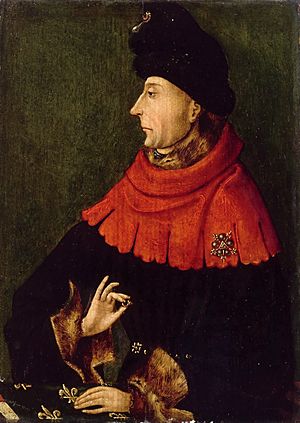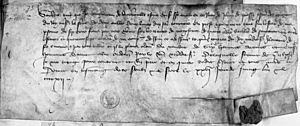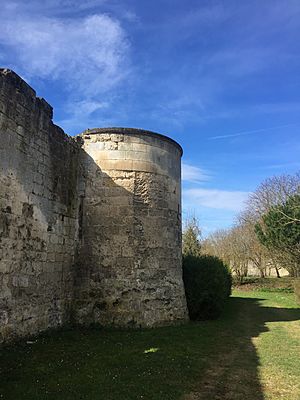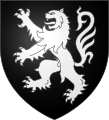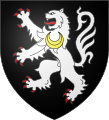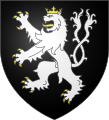Enguerrand de Bournonville facts for kids
Quick facts for kids
Enguerrand de Bournonville
|
|
|---|---|
| Born | c.1368 |
| Died | 26 May 1414 Soissons |
| Rank | Squire |
| Battles/wars | Armagnac-Burgundian Civil War |
| Spouse(s) | Julienne de La Motte |
| Children | Antoine de Bournonville |
Enguerrand de Bournonville (born around 1368 – died May 26, 1414) was an important military leader. He served John I of Burgundy during a big conflict in France called the Armagnac-Burgundian Civil War. Enguerrand came from the Bournonville family, a noble family known for producing many generals. He was the younger brother of Aleaume de Bournonville and owned several smaller land areas.
Enguerrand started his career as a squire, a young nobleman training to be a knight, first for Philip II of Burgundy and then for his son, John I. He fought in many places, including Italy, Pisa, Genoa, and a region called Pays de Liège. He played a key role in the Battle of Othée. He also fought in areas like Île-de-France, Berry, and Picardy. Enguerrand became a top general, often leading more than a hundred soldiers, including family members like his cousin Lyonnel de Bournonville.
John I of Burgundy often gave Enguerrand money and rewards. This, along with treasures he won in battles, helped him become very wealthy. Enguerrand was in charge of the city of Soissons when Charles VI of France's army attacked it. During this siege, a famous soldier was killed by a crossbow bolt. After Soissons was captured, Enguerrand de Bournonville was betrayed by Simon de Craon and was executed by the king's orders.
One historian called him "the flower of all the captains of France," meaning he was the best of all French military leaders. People who supported Burgundy remembered him as a hero. A tomb found in a church in Marle, Aisne in the 1800s was first thought to be his. However, it was later discovered to be the tomb of his son, Antoine de Bournonville.
Contents
Enguerrand's Early Life and Family
A Noble Family from Boulonnais
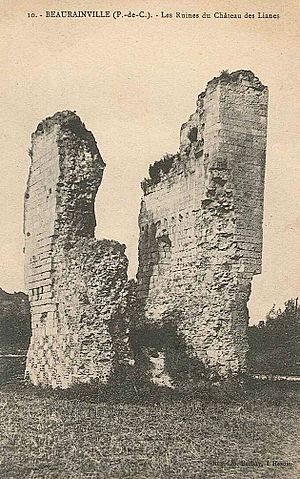
Enguerrand de Bournonville belonged to the Bournonville family. They were a noble family from a region in France called the Boulonnais, where they owned several important lands. Enguerrand was the third son of Robert I de Bournonville and Jeanne de Cramailles. His older brother was Aleaume de Bournonville (1360–1415), and his first cousin was Lyonnel de Bournonville (around 1390–1429). Their grandmother, Mahaut de Fiennes, made them great-nephews of Robert de Fiennes, a very high-ranking military officer in France.
As a younger son, Enguerrand did not inherit the main Bournonville lands. These went to his older brother, Aleaume. Enguerrand did receive the lordship of Lianne. He officially took control of it in 1403. The castle of Lianne was located in what is now the town of Beaurainville, overlooking the River Canche. Around 1400 or 1401, he married Julienne de La Motte. She was a widow who owned lands in Pernes, Havenquerque, and Huplandre. Enguerrand and Julienne had two children: Antoine de Bournonville, who later became lord of Bournonville (around 1403 – 1480), and Béatrice de Bournonville.
Starting as a Squire for the Dukes of Burgundy
Enguerrand de Bournonville began serving the Dukes of Burgundy between 1390 and 1400. This was when Philip II of Burgundy was bringing important noble families from Picardy into his court. Enguerrand was first mentioned in Philip's group in 1404 as an "écuyer d'écurie," which means a squire in the stables. After Philip's death, he served Philip's son, John the Fearless. This title was given to nobles who didn't have a direct feudal link to the Duke.
Enguerrand's career happened during a big power struggle in France. The Armagnacs (who supported the dukes of Orléans) and the Burgundians (who supported the Dukes of Burgundy) were fighting to control the French government. This was because Charles VI of France was often unable to rule due to periods of mental illness.
On May 2, 1405, Enguerrand was captured while fighting the English. His cousin, the Count of Saint-Pol, was in command. John the Fearless quickly paid his ransom in June, which made Enguerrand feel very loyal to him. This was the first time their names appeared together in official papers. On September 1, 1405, Enguerrand was called an "escuier et cappitaine" (squire and captain) in the Burgundian army. He commanded 148 soldiers in a fight against Louis d'Orléans.
In 1406, John and Louis d'Orléans, who were temporarily friends, decided to rule Pisa together. John sent Enguerrand to Pisa as his representative. Enguerrand was welcomed there on July 7, 1406. However, the city was under attack, and the Florentines captured it and Enguerrand in October. He was recorded back at John's court in November 1407.
Enguerrand worked directly for Philip and John. His brother Aleaume, however, served the Count of Saint-Pol, who was a cousin and advisor to the Duke of Burgundy.
Enguerrand's Military Career
The Battle of Othée
From 1408, John the Fearless often made Enguerrand de Bournonville the head of his personal guards. This was very important after the Duke of Orléans was killed. Enguerrand was also one of the Burgundian captains who joined John's campaign in the Pays de Liège. They were supporting the prince-bishop John III against the people of Liège, who had rebelled. Bournonville led a company of over 150 men, including five from his own family, like his cousin Lyonnel de Bournonville. He took part in a destructive military raid in the area. He also fought in the Burgundian victory over the people of Liège at the Battle of Othée on September 23, 1408.
At Othée, Enguerrand was one of the commanders of a group of 1,400 cavalry. They surprised Liège's forces by moving around them and attacking from two sides. This move seemed to decide the battle.
John was very pleased with Bournonville. He gave him large financial rewards. Bournonville was even shown in a tapestry about the battle, which was made in Arras. In 1409, Bournonville was promoted to chamberlain. Chamberlains were the most important people in John's household. Only a small number of them were squires like Bournonville; most were knights. In Bournonville's family, the older sons, like Aleaume and Enguerrand's son Antoine, became knights. Younger sons, like Enguerrand himself, remained squires.
A Burgundian in Paris
In 1409, Bournonville joined a joint expedition to Italy with several French princes. He commanded a hundred men, including an artilleryman. He tried to help Marshal Boucicaut during a revolt in Genoa, but they failed to keep control of the city. Bournonville returned to France in early 1410. As tensions grew between the princes, he stayed in Paris with John the Fearless. He was officially made John's advisor. After a peace agreement was signed in November 1410, John put his loyal men in key positions. Bournonville remained loyal to John. He also joined the king's court as "commissary to the guard of the château du Louvre." He became the head of the bodyguard for Louis de Guyenne, who was the Dauphin (the king's eldest son and heir).
Enguerrand and his wife had two young children who were still with their mother in 1418. It was common for captains in the Burgundian army to have a second home in Paris. John the Fearless himself had an illegitimate son born in Paris.
A Successful and Wealthy General
In January 1409, John the Fearless made Bournonville the castellan (the person in charge of a castle) of Éperlecques castle. This was a well-paying job. The years 1410–1411 were very good for him financially. In September 1410, he got back his land in Lianne. He had lost it for many years, likely because of the influence of the Duke of Orléans's widow. He also bought other lands. In total, he received more than 2,000 livres in rewards from John. It was common for John to support his captains financially. He wanted the nobles in his lands to live in a way that suited their high rank.
This was the best time in Bournonville's career. In 1411, when open fighting began between the Armagnacs and the Burgundians, he was among the top Burgundian generals. The king officially asked him, Antoine de Craon, and David de Rambures to fight the Armagnacs. He defended Paris, which was then controlled by the Burgundians, against the forces of the Duke of Orléans. At the same time, the Count of Saint-Pol put Bournonville in charge of teaching military skills to his young nephew, Jean II de Luxembourg-Ligny. This nephew would later be the lord of Enguerrand's son, Antoine. In 1411–1412, Bournonville fought near Paris, at Senlis, La Chapelle, and Saint-Cloud. He then attacked Étampes, Beauce, Poitou, and Berry. He forced Dun-le-Roi to surrender and took part in the siege of Bourges in June 1412. After a peace treaty was signed between John and the Duke of Orléans, Bournonville stayed in Paris from November 1412 to August 1413.
Bournonville also gained a lot from taking goods and lands during the war. John approved of this. In 1413, John joined with Georges de La Trémoille to take the goods of Pierre des Essarts, who was the provost of Paris and had recently been killed. John seemed to allow this taking of goods as a way to keep his supporters loyal. John's lawyers were not happy about such looting. However, the Burgundian knights thought it was good to take the lands and goods of John's enemies.
As a younger son of a noble family, Bournonville was a relatively minor nobleman among the Burgundian captains. This was especially true compared to captains from royal families, like Jean de Chalon-Arlay, the prince of Orange. Bournonville remained a squire his whole life, even though most of John's captains were knights. Still, he led large groups of more than a hundred men. In 1412, his company was part of a larger group of over 1,000 men serving the king. Over time, more knights joined the army compared to squires. Some of his men were from Picardy, especially around the Boulonnais. Seven of his relatives and six cousins, including Guillaume de Bournonville and Lyonnel de Bournonville, served in Enguerrand's companies. Some foreigners also served with him, like a knight from Bohemia. Organizing companies around family groups and local loyalties was common throughout France.
The Siege of Soissons
The Burgundians lost control of Paris in autumn 1413. This meant the Armagnacs now controlled the French government, and John's supporters lost their important government jobs. In 1414, John decided to try and take Paris back. He sent three of his chamberlains (Bournonville, Antoine de Craon, and Jean de Moreuil) to capture the strong fortress of Soissons. They succeeded on February 2, 1414. After failing to capture Paris, John went back to Artois in mid-February. He made Bournonville the captain of Soissons. Bournonville made the city's defenses stronger. He tore down buildings too close to the walls, blocked streets with chains, and took supplies from the nearby countryside. This was to prevent the attacking army from getting resources.
The royal army, on its way to fight in Artois, arrived at Soissons in early May. Its first group was led by Édouard III de Bar, Clignet de Brabant, and Amé de Sarrebruck. They sent messengers to demand the town surrender, but Bournonville refused. A siege began. On May 10, Hector, the illegitimate son of John I of Bourbon and a captain in the royal army, was wounded in the throat by a crossbow bolt. He died the next day. This death was very bad for Bournonville. It caused great sadness and anger in the royal army. Crossbows allowed even a common person to kill a nobleman, which upset the social order. The Church had banned crossbows, but this ban was mostly ignored because they were so effective in battle.
Charles VI of France himself led the siege from May 11. But Bournonville refused a second demand to surrender. The royal cannons blasted holes in the city walls. The suburbs and the fortified abbey of Saint-Médard, an important part of the town's defenses, surrendered. Bournonville decided to escape the town on the night of May 20–21. However, Simon de Craon, a Burgundian captain who was changing sides, stopped him. The attackers used the confusion in the town to attack. They captured Soissons in a two-hour assault on May 21, ending the siege.
Death and Legacy
Historians describe Bournonville's role and how brutally the town was treated after the attack. However, they disagree on why he was sentenced to death. He was condemned as a rebel against the king's authority. Perhaps John I of Bourbon demanded his execution to get revenge for his half-brother Hector's death. Some noblemen in the royal army tried to save him, but they failed. On May 26, Bournonville was beheaded in the marketplace in Soissons. His head was then placed on a spear, and his body was hung from a gallows. Many of his comrades were also beheaded or hanged. One or two were pardoned, like Bournonville's soldier Guillaume de Crannes, thanks to a request from the Duke of Alençon.
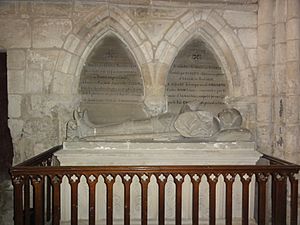
A note from the 1600s says that Enguerrand was buried in the church of Saint-Médard Abbey in Soissons. Nothing of that church remains today. Despite this, a tomb statue in the church in Marle was long mistakenly believed to be Enguerrand's. It was originally in a side chapel, which seemed to be called the Bournonville chapel. It was moved and changed a lot around 1850. Almost nothing of the original statue is left. However, the tomb beneath it was dug up in 1867. The person who dug it up thought the body was Enguerrand's. But a document from 1634 proves that the body was actually his son Antoine, who died in 1480. This information was lost, and in the 1800s, the tomb was mistaken for Enguerrand's.
John the Fearless was saddened by Bournonville's death. He had a special church service held for his soul. He immediately gave Enguerrand's job as castellan of Éperlecques to his twelve-year-old son, Antoine de Bournonville. However, the actual work was done by a lieutenant. John also rewarded Bournonville's Parisian mistress. Enguerrand de Monstrelet, a historian who supported Burgundy, wrote that "By renown he was the flower of all the captains of France." Burgundian writers also praised his bravery and loyalty. A long poem from 1422-1425 compared Bournonville to the famous hero William of Orange. It said, "He is dead, God has his soul, / He who was worthy of William of Orange."
Heraldry
The Bournonville family's coat of arms was a black shield with a silver lion. This design was probably adopted when Mahaut de Fiennes married Jean II de Bournonville, Enguerrand's grandfather. It was a reversed version of the coat of arms of Mahaut's brother, Robert de Fiennes.
As a younger son, Enguerrand used the family coat of arms with a small crescent moon added to show his position. His full coat of arms was a black shield with a silver lion. The lion had red claws and tongue, and a gold crescent moon on its shoulder. He also had two "supporters," which are figures holding up the shield: a wild man on the right and a griffin (a mythical creature) on the left.
The coat of arms showing a crowned lion with a forked tail was not used by the Bournonville family until the early 1600s.


